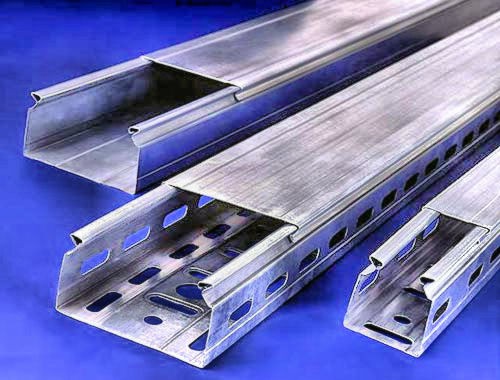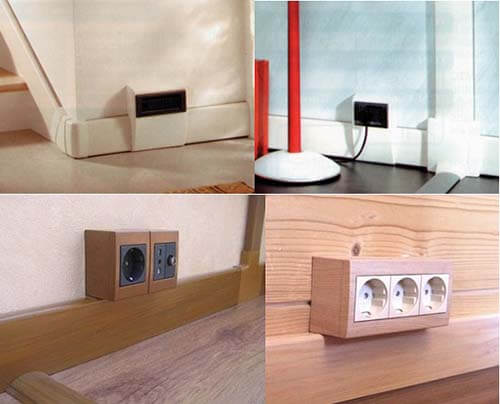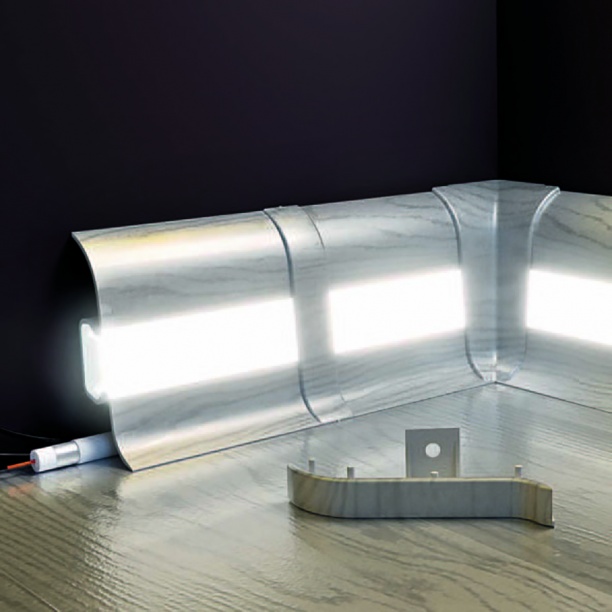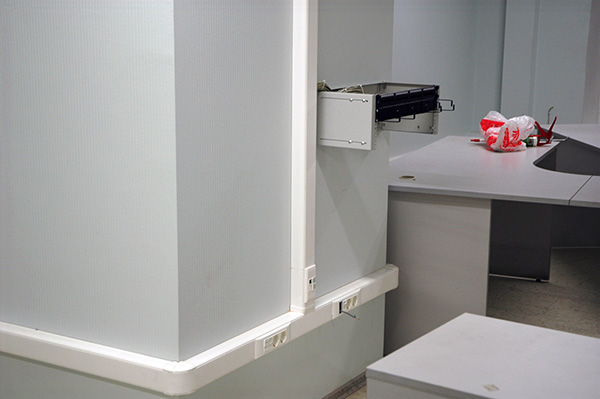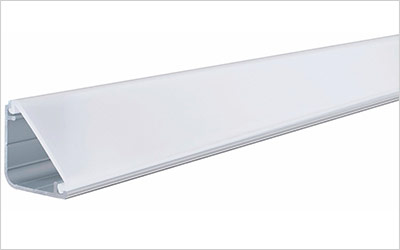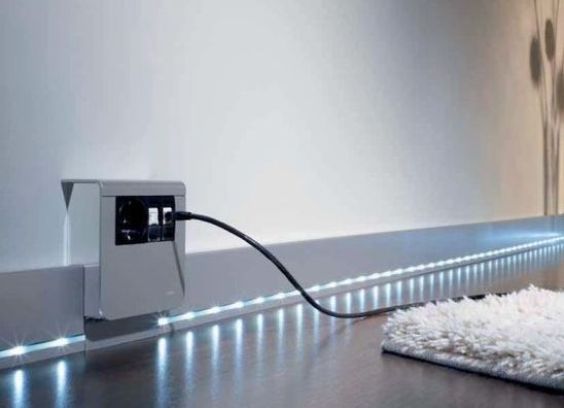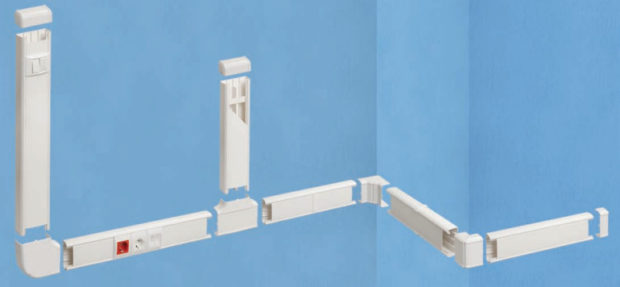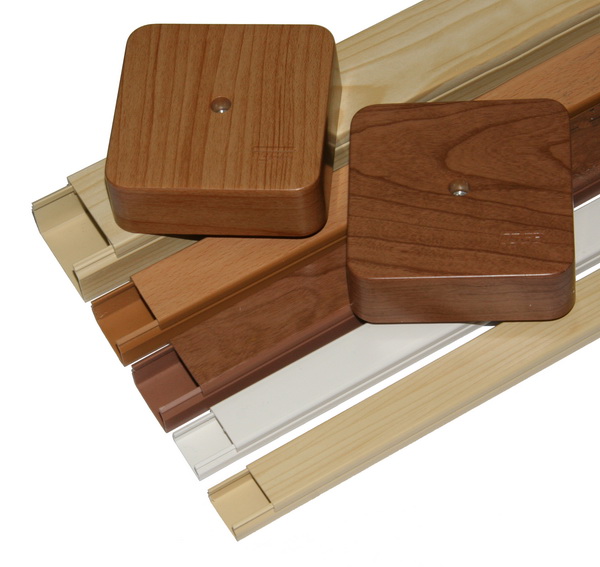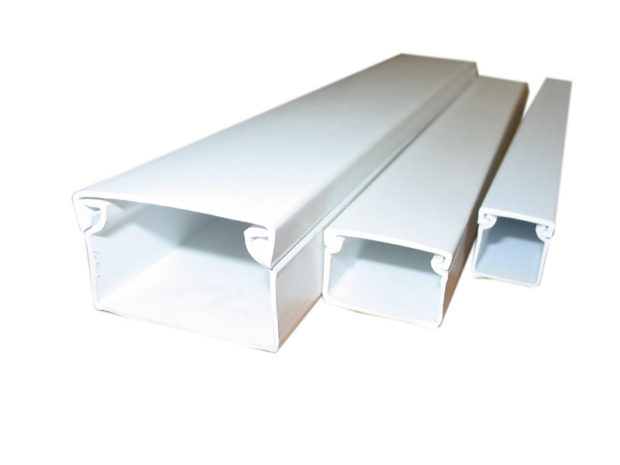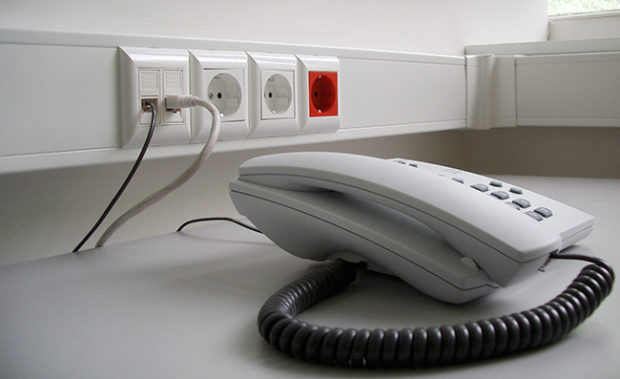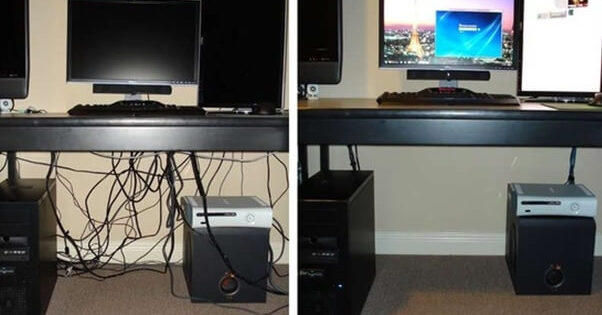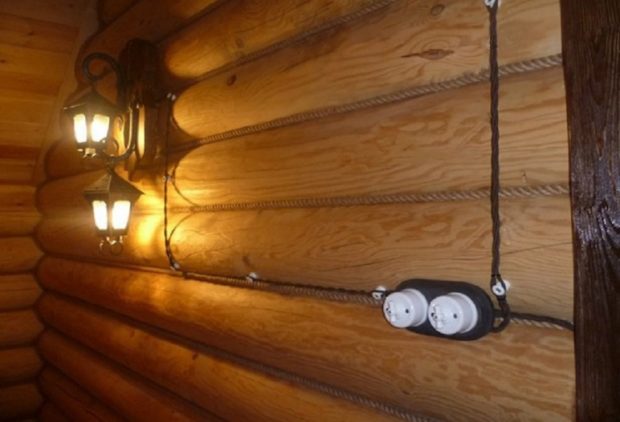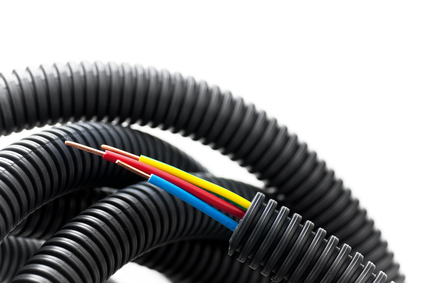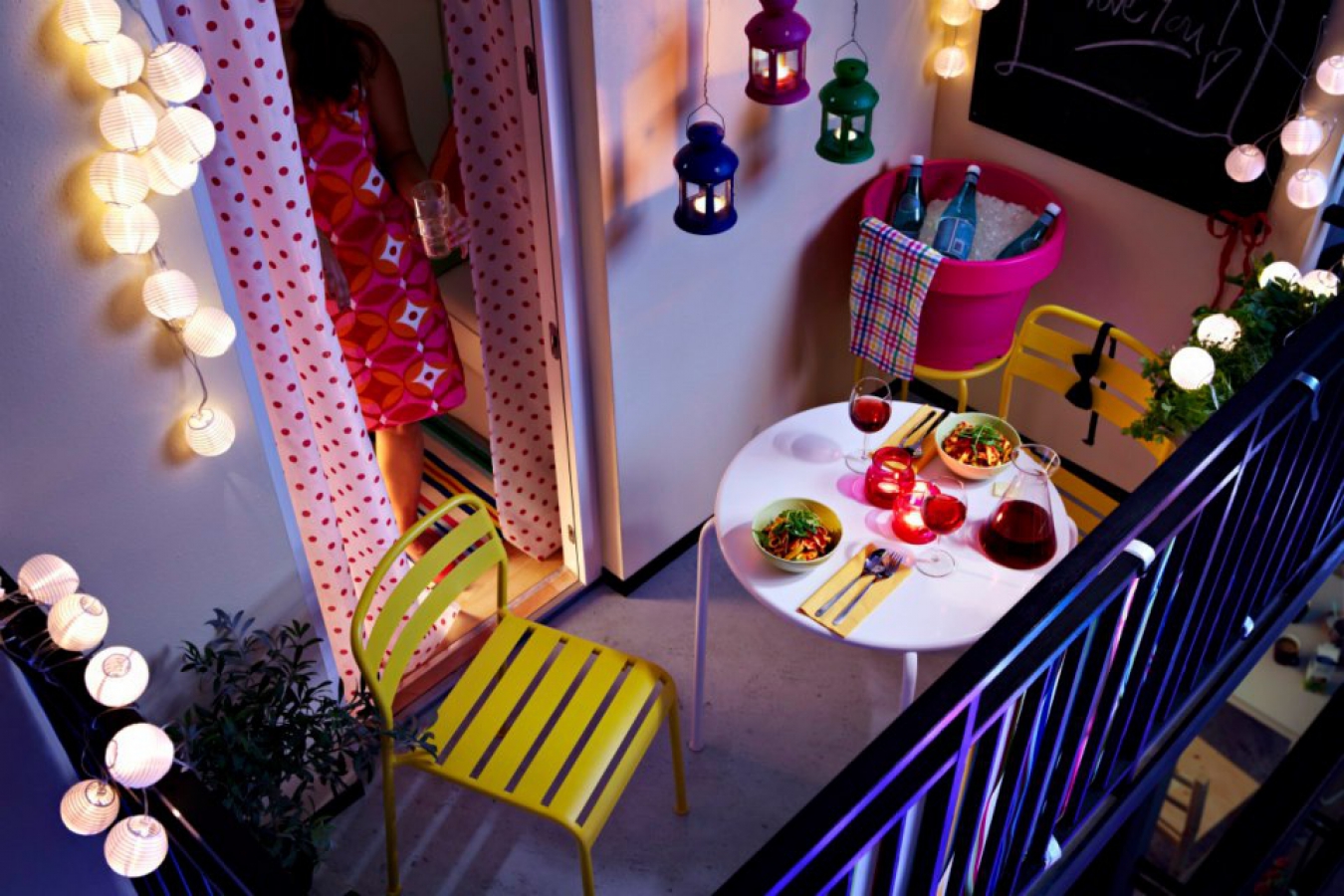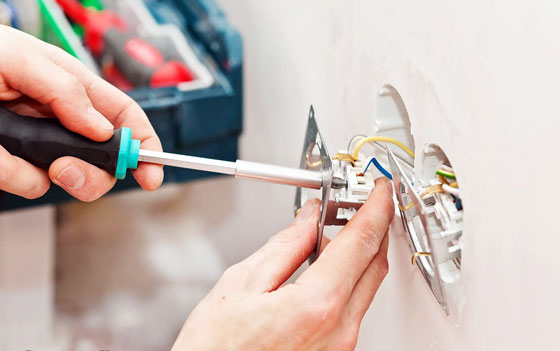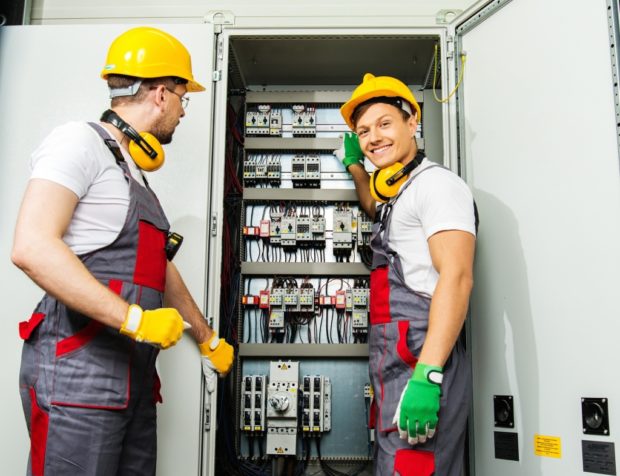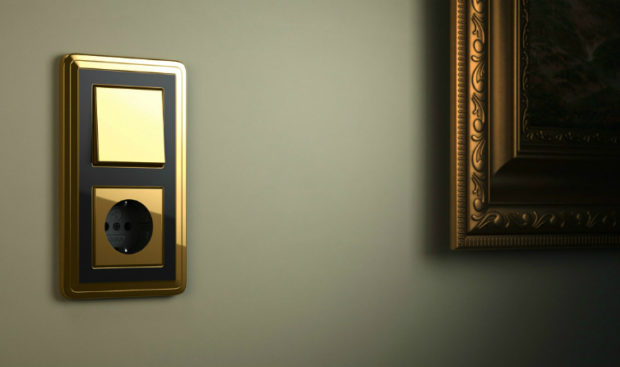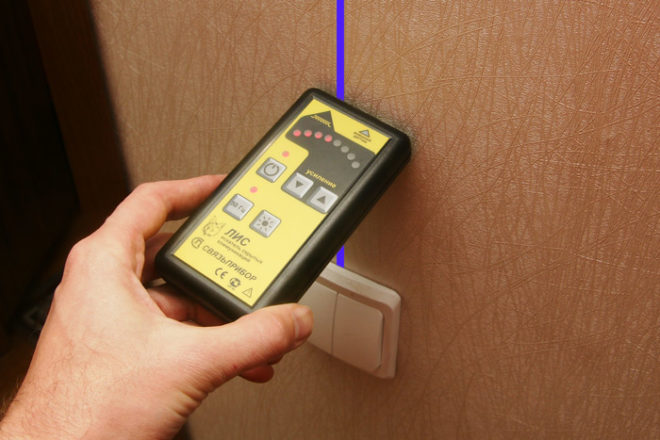9 tips for choosing a cable channel for wiring: size, types
Concealed wiring is a standard of safety and aesthetics. But there are times when you have to lay open wiring. The most striking example is wooden houses. Or if the repair is already completed, the walls are finished, and it turns out that the wiring system does not meet the requirements put forward. The best way to hide the electric cable, protect it from external influences and preserve the aesthetics of the room is to use special cable channels. Previously, it was only gray or white nondescript structures, but today they can look like an ordinary baseboard and imitate the texture of a tree. We figure out how to choose a cable channel for wiring, determine the size, types and materials.
No. 1. Basic selection options
The cable channel is a special hollow design with space for electrical wires. The product consists of a tray that is installed on the surface of a wall, floor or ceiling, and a cover. There is a box with a slightly different design, but this is the most common. Also, cable channels can be used for laying telephone, Internet and television lines, often they are used to mask the wires of air conditioners. IN large offices, where it is necessary to provide each workplace with electricity, the Internet and a telephone line, cable channels are completely irreplaceable.
When there is no way to hide the wiring in the wall, the cable channel is a real salvation. Main advantages a similar solution can be called:
- protection of wiring from ultraviolet and mechanical stress;
- improving the fire safety of the room, although many are ready to challenge this moment, because the cable channel is a closed space, and the wires will certainly heat up, i.e. heat remains inside the structure, which means that the risk of ignition is much higher than when laying a wire without protection. But it is worth considering the fact that the cable channel is a sealed structure, there is almost no oxygen supply, so that the fire cannot spread, and the ignition goes out. In addition, there are perforated channels that cool heated cables due to the influx of fresh air;
- the ability to instantly replace the wire or laying a new branch. If the cable is in the wall, then any manipulation will lead to serious damage;
- the ability to lay several wires in one channel, including different types, for example, wiring and telephone line. For these purposes, there are special designs with internal partitions;
- quick wiring.

As minus usually called low esthetics, since a plastic channel stretching along the wall is unlikely to decorate the room, but everything is known in comparison. A neat cable channel is clearly much better than a dangling bundle of wires. If you take into account the presence of numerous channel modifications, then the wiring can be made almost invisible.There are products that can not be distinguished from ceiling or floor skirting, there are models with a wood look - there are a lot of options, however, such solutions of increased aesthetics are more expensive than the simplest white plastic products.
The disadvantage is the fact that the cable takes up a bit of space. Yes, often such a loss does not cause inconvenience, but there are times when every centimeter counts. In addition, high-quality wiring using cable channels is possible only when using a large number of auxiliary elements, i.e. except for the channel itself, tees, angles, etc. will be needed. Keep in mind the fact that the protruding element on the wall or floor is easily hooked and damaged.
When choosing a cable channel for wiring Consider the following factors:
- performance material, which affects the level of durability, strength and resistance to fire;
- design features. The cable channel can be with a rectangular, angular or semicircular section, it can be flexible or lattice - there are a lot of variations, each will be indispensable in a particular situation, and we will consider each view below;
- features of the roomwhere is executed wiring. For example, the channel for a wooden house must meet the increased fire safety requirements, and for movable structures to use stationary cable channels is unacceptable;
- appearance. Aesthetics are important for residential premises, so the color and shape of the cable play an important role;
- the size. The more wires you need to hide, and the larger their cross-section, the more cable channel will be needed, but we will return to this.
No. 2. Cable channel material
The most popular channels are plastic, less commonly used metal. Is there some more ceramic cable ducts, but they are expensive and not very practical, because they are rarely used.
Plastic cable channel for electrical wiring
Due to the budget and ease of installation, plastic channels have gained the greatest popularity. Products are made from PVC with special substances, which increase the resistance of the material to sunlight, fire and aggressive chemicals. As a rule, channels have a U-shaped cross-section, but can be triangular in the form of a hemisphere, as well as W-shaped, when inside there are partitions for cables of several types. They are used for laying low-current and power lines in residential premises, offices and at enterprises.
Benefits:
- low price;
- minimum weight;
- operation in a wide temperature range, from -32 is possible0From to +900FROM;
- quite simple installation due to the simple fastening system and low weight;
- resistance to corrosion;
- enough variety. Channels are available in various shapes and colors, you can choose a product that will be as similar to a regular floor baseboard and made as a tree;
- the construction will require minimal maintenance;
- The material is easy to cut.

The cover of the plastic cable channel is installed as simple as possible - no additional tools are needed. The standard length of one section of the plastic channel is 2 m, the width and height range from 10 to 60 cm, but other options may also occur.
The plastic cable duct can be attached to the surface with screws, metal staples or dowel nails. The fixed mount provides for gluing the channel to the wall, but here it is important to take into account the weight of the product. In order to hide wiring of any complexity, except for direct channels, additional elements are produced, such as tees, angles and plugs. Separate elements are even for sockets and switches.
Despite the rather high fire resistance and self-extinguishing ability, plastic cable ducts are not recommended for use in rooms with increased fire hazard.
Metal cable channel for electrical wiring
Metal products withstand increased loads, therefore they are used mainly in enterprises, and not in residential premises. They are used for internal and external cabling. Products are great when you need to hide an impressive bundle of wires.
Metal cable channels are made of:
- galvanized steel;
- anodized aluminum.

Box galvanized steel possesses high mechanical and corrosion resistance, becomes protection against electromagnetic rays, therefore it is often used for laying cables of video surveillance and warning systems.
Anodized aluminum box also becomes a good barrier to electromagnetic rays, it is resistant to fire, mechanical stress, durable, not afraid of sunlight.
The metal cable, as a rule, has a U-shape, can be solid or perforated. If the base is flammable, then use an integral channel. Separately, it is worth highlighting the stairways - they are used only in production conditions. The channels are fixed to the base with dowels, anchors or bolts.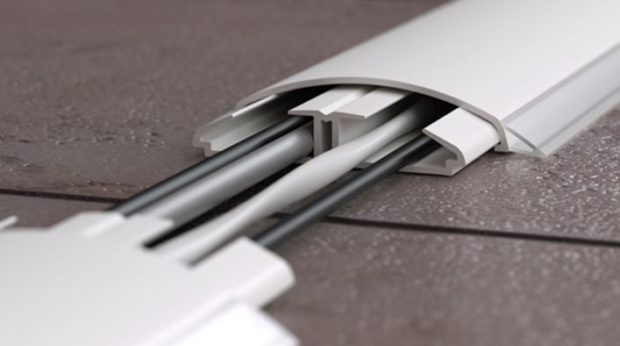
The main advantages of metal cable channels:
- resistance to fire;
- high strength to support the weight of a whole bunch of power cables;
- durability and resistance to mechanical damage;
- protection against electromagnetic radiation, which is important for communication cables.
Of cons we note a more complex installation compared to a plastic channel: since the weight of the metal is greater, the installation process is complicated, but it is still impossible to call these works especially difficult. Due to the presence of a latch with a latch, assembly is carried out in a fairly short time. Complex systems are assembled due to the presence of T- and X-shaped parts, as well as angles of different configurations.
No. 3. Types of cable channels by design
There are a lot of different cable channels, and in many selection guides all types are shown in bulk. To make it more convenient, we propose to first divide all product options by type of design, and then by installation features.
According to the type of construction, the existing assortment of cable channels can be divided into the following types:
- smooth, with a solid body without holes, Is a fairly popular option. The material of manufacture is plastic or metal. Great for wall and ceiling mounting. Since the structure is sealed, there should be enough free space inside so that the wires do not heat themselves and provoke a fire;

- perforated cable ducts they weigh less and cost less, but these are not their main advantages. Holes provide efficient ventilation, so that the risk of cable overheating is minimized. An additional convenience - in some places, the teeth can be broken out and a sufficient hole can be obtained for outputting the wire to a socket or switch, which is very convenient. The disadvantage is low aesthetics: such a channel does not completely hide the wiring, therefore it is rarely used in residential premises. If the wall material burns easily, it is better to use a smooth channel;

- flexible cable channels - an alternative to more familiar hard products. The latter are well suited if the surface has the correct geometry. If the room is a lot of non-standard architectural elementsIf there are rounded surfaces, it is better to use flexible cable channels. They are several types: tubular, rubber and flexible chains (so-called tracks). Another option is smooth tubes made of soft plastic. Rubber and plastic channels protect the cable well from any damage, therefore they can be used even in rooms with high humidity, with the exception of baths and saunas. Tubular channels are made of metal twisted into a spiral. Such products can be bent in different directions. Flexible chains tend to bend in the same plane and can be made of metal or plastic.Often, trucks are used in the production environment to connect equipment. Cable tracks can be closed and open type. The first are used when the cable needs protection from moisture, dust and other negative environmental influences. If there is no source of a dangerous effect on the wire at the place of installation, then an open type flexible track can be taken - it is cheaper and easier. Separately, we note a flexible channel with the function of three-dimensional circular rotation, individual elements, if necessary, can be removed from it or, conversely, added. These are quite expensive products that have so far found application in the creation of robotic mechanisms. However, even the most ordinary flexible channels are more expensive than similar rigid options, so they are used only in places with a complex surface topography;

- wire channels allow wires to be ventilated efficiently and provide the easiest access to cables. These are the cheapest cable channels, they are widely used in production and storage facilities;

- stair canals receive a reinforced structure, are used when laying heavy cables, are made only of metal. In private construction are not used;

- transparent channels - This is more a design decision than a constructive one. This is a channel with a triangular section, designed for installation at the junction of the floor and walls, ceiling and walls, walls and wall cabinets. The longest side in such channels (hypotenuse) is made of transparent or translucent plastic. This product is intended for installation only. LED strip lights, or for simultaneously laying the cable and backlight.

Number 4. Types of cable channels for installation features
Wiring, telephone and Internet lines can run along walls, ceilings, floors and corners. Each case has its own type of cable channel:
- wall products have a square or rectangular section, the sizes fluctuate in a wide range, which allows you to equip systems of any complexity;

- mini cable channels - variation of wall boxes. The main feature is the minimum dimensions, which allows you to very accurately fit the product into the interior. The channel remains almost invisible, especially if you select it in the color of the wall. Such a product is designed for laying single wires or several thin cables, often used in the installation of television, telephone and Internet lines. To create various configurations, corners, plugs and tees are used, but these elements are not cheap, and are not often found on sale, so craftsmen just file channels at the right angle to create a right angle, it works well. Fasten mini cable channels to screws, dowels or duct tape. The latter option is especially convenient when laying wires on furniture (for example, under a table);
- floor cable channel differs in hemisphere shape. Thanks to this decision, the risk of tripping over the box and getting injured is negated. In apartments, this type of channel is not used very often. The products are much more popular in large office premises such as open space, when in one area it is necessary to provide many working places with appropriate conditions. In this case, electricity, Internet, a telephone line in floor channels are brought to the tables. Strength requirements for such products are increased. It is better to take an aluminum box. It will also fit plastic, but not ordinary, but reinforced, with additional partitions, which can also be used as a separator between wires for various purposes;

- angular have a cross section in the form of a right triangle, designed for installation under the ceiling, at the junction of the wall and ceiling surfaces. In appearance, such a box is easily confused with the simplest skirting boardso that the product will not be able to harm the aesthetics of the room.Like other cable channels, it consists of a tray and a cover, the latter being transparent or opaque. Products with a transparent cover are used to install LED strips;

- skirting board with cable channel - This is the best example of combining business with pleasure. In appearance the product is no different from the usual skirting boardcan be of almost any color and shape. The internal cavity is intended for the location of wiring cables, the Internet, cable television, and thanks to external and internal corners, corners and splitters, you can create a very complex configuration. There are even sockets and socket groups that can be successfully entered into the floor plinth. If you need to stretch a whole bunch of wires, then this option is unlikely to work, since there should be enough space inside. The main disadvantage of such channels is the high cost, but they allow you to abandon the dirty and complex process of wall breaking;

- parapet cable channels resemble baseboards, but are installed at a small height from the floor (80-100 cm), they have a symmetrical section and a sufficient width. Products have gained wide popularity when wiring in offices and various institutions, such channels are not suitable for home interiors, as they will be very striking, the exception is loft style interior.

No. 5. Cable duct size for wiring
The length of the straight sections of the cable channel, as a rule, is 2 m, products of a different size are less common. Width and height are more variable parameters. The choice depends only on how many wires will be hidden inside, and what section they have. It is recommended to leave enough free space inside the cable channel so that the wires do not overheat. In paragraph 2.1.61 of the PUE it is said that in boxes with open lids, the wires must no more than 40% of internal space, for boxes with blank covers, this figure is lower - 35%. It turns out that in order to choose the right cable channel for electrical wiring, you need to calculate the sum of the cross-sections of all the wires, and already start from this when choosing the dimensions of the box itself.
In practice, things are a little easier than it seems. Many manufacturers indicate how many and which wires can be placed in a particular cable channel. Cable channels of the following sizes in mm are considered popular: 12 * 12, 10 * 20, 10 * 30, 16 * 16, 16 * 20, 16 * 25, 16 * 40, 16 * 60, 25 * 25, 40 * 40, 60 * 60, 60 * 80, less common are 100 * 150. Mini cable channels have dimensions 10 * 10 and 10 * 15 mm. On sale you can find products of other sizes. When choosing, it is important to pay attention to fittings of a suitable size, which will allow you to build a neat system.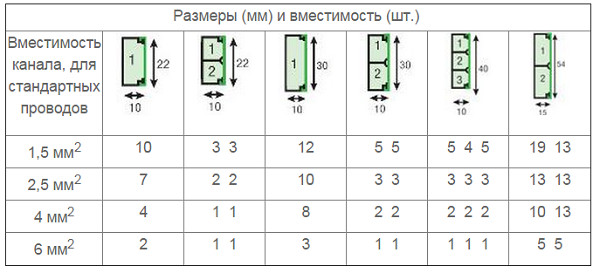
No. 6. Color and design of the cable channel
The main task of the cable channel is to protect the wires, but nobody canceled the aesthetics either. It is desirable that the product dissolves against the background of the surface to which it is attached, fits as much as possible into the interior and does not attract too much attention. Fortunately, in terms of design options for cable channels is enough:
- the most popular became white channels, they are cheaper than the rest, for them there are a lot of different accessories. Ideal for apartments with ceilings and white walls, as well as for non-residential premises;
- gray and black cable channels used in manufacturing and in offices. Certain types of channels (for example, floor and parapet) are available in only three basic shades: white, black and gray;

- baseboards and wall cable ducts often do under the tree different breeds. Such products look spectacular - the main thing is to find suitable accessories;
- colored boxes come in many different shades, some manufacturers even agree to paint in a specific color. If you pick up the box to match the walls, it will be almost invisible;
- ducts in the form of brass or bronze tubes - An ideal option for decorating a room in retro style, however, it will be more difficult to get all the necessary wires into such a channel;
- box traditional metal shape - A good option for rooms in a modern style.

If you are a fan of the loft style, then you don’t really need to hide the wiring - this direction requires a demonstration of communications.
Number 7. How to evaluate the quality of the purchase?
When buying, carefully inspect the selected sample. A small examination will allow you to understand how high-quality the product is in front of you:
- the plastic must be stiff enough to hold its shape properly. Cracks, dents and other deformations are not allowed;
- perfect geometry, smoothness and evenness of the ends - evidence of high quality
- The cover should be easy to install and remove. Better try a couple of times to close and open the lock. If all this happens very easily, and there are no cracks on the plastic, then this is a quality product;
- evidence that the manufacturer responsibly approached the channel production issue is the presence of dividers, clips and cable ties for convenient laying of several different cables. Yes, such bells and whistles are not in every quality channel, but their presence says that this is a really good product.

Number 8. Cable Channel Manufacturers
As you know, the name of the manufacturer is a kind of quality guarantee. If substantial funds have been invested in advertising and promotion, then who wants to spoil all this with dubious products. Among the leaders in terms of production of cable channels it is worth noting:
- Hager - A German company that produces mainly channels for office premises, but their attractive appearance allows the use of products in residential premises;
- Schneider electric - A large European corporation with factories around the world, including and in Russia. The assortment of cable channels is one of the widest among all competitors. There are plastic and metal products, models for mounting on the floor and walls, boxes of various sizes are presented, including and mini versions;
- BCS - channels of domestic production, there are wall and floor options, as well as mini cable channels. The assortment of colors is not very large, but in most cases it is quite possible to find a suitable product;
- Legrand - A group of companies with offices around the world, produces a wide range of products under different brands. Cable channels are represented by plastic and aluminum options, floor and wall models, sizes vary widely;
- IEK - a domestic manufacturer, offers parapet and wall cable channels of different sizes, color - white and wood imitation.

No. 9. Features of the installation of cable channels
Installing cable channels is a simple procedure, and if you dare to do wiring with your own hands, then installing boxes will not be a special problem. In general terms, this process goes this way (in more detail - in the video):
- cable channels are placed only vertically or horizontally, which is not surprising, given the requirements put forward for the installation of electrical wiring. Inclined sections are allowed to be done on stairs and attic floors;
- the cable channel is fixed to fasteners or adhesive tape / glue. The method with self-tapping screws is more universal, just keep in mind that for drywall and foam blocks need special hardware. It is better to choose self-tapping screws with large caps, otherwise the plastic box may become deformed. Self-tapping screws are installed in increments of 30-50 cm, with sufficiently curved walls you can reduce the pitch to 20 cm, and for perfectly even walls, increase to 60-70 cm. First, holes must be made in the channel tray, then attach it to the wall, mark it on its surface fastening points, drill holes in the wall, install plugs and only then proceed with the installation of dowel-nails;
- if you don’t feel like drilling a wall, you can stick the channel onto glue or double-sided tape.In this case, increased demands are made to the base: it must be smooth, even and dust free;
- It is better to trim separately on the tray and lid, but you need to outline the cut line when the lid is installed on the tray. For cutting, you can use a plastic saw or a sharp knife, the edges are processed with sandpaper. A metal box is cut with a hacksaw;
- after the channel tray is installed, start laying the wires, and then close the box lid.
Finally, we note that the wires can be hidden in corrugated and reinforced pipes made of PVC and metal, but they are often used to protect wires in gates. They are also applicable for outdoor wiring, when the aesthetic result of the work done is not of great importance.



